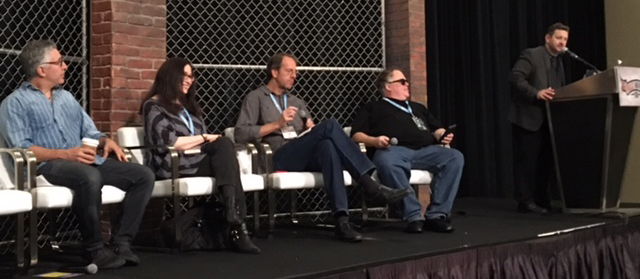Earlier this month, I hosted a Podcast Makeover at the Podcast Movement conference in Chicago. We gathered a panel of radio and podcasting veterans — including Doug Berman, Executive Producer of NPR’s Wait Wait Don’t Tell Me! and Car Talk, legendary shock jock Tom Leykis, talent coach and author of Beyond Powerful Radio, Valerie Geller, and Spreaker’s Head of Content Rob Greenlee — to aircheck two podcasts live on stage.
We brought our brave podcasters on stage as we played the first 60 seconds of a recent episode for the audience to hear. Then we invited our panel to critique the show openings, telling the hosts what was working and what they could do better.

It immediately became obvious how crucial the first minute of a podcast is for listeners, particularly listeners who may have never heard another episode of the series before. Leykis explained that he never assumes that people are familiar with his show; instead, he makes sure that every show he does is accessible to somebody even if they are listening to him for the very first time.
Here’s how you can do the same with the first 60 seconds of your podcast:
1. Explain the show.
It’s helpful to have a tagline that succinctly explains what your podcast is all about. We pointed out that at the beginning of Wait Wait…Don’t Tell Me!, the announcer follows the title of the show with the tagline, “The NPR News Quiz.” The tagline for my Taste Trekkers podcast is, “The podcast for foodies who love travel and travelers who love food.”
When Marc Maron interviewed Will Ferrell for his WTF podcast, he made an extra effort to explain the concept of his show to new listeners. He knew Ferrell’s huge fanbase was likely to attract new listeners to his podcast, so he even used phrases like, “If this is your first time listening to the show…” You should do the same in every episode.
2. Tell listeners what’s in it for them.
Valerie Geller stressed that hosts need to make the podcast about the listener from the moment the show opens. Don’t assume that people know why they should listen to your podcast; tell them why they should.
At the beginning of my new podcast, DASH: The Future of Radio in the Connected Car, I explain that new cars now have a computer at the heart of the dashboard, not a radio, and that this change will have a huge impact on radio broadcasters. Broadcasters should listen to my podcast so they can gain a better understanding of this issue that will affect their career. By the same token, at the top of your podcast, explain to listeners why your show will be meaningful for them.
3. Offer a roadmap for the episode.
Once you’ve explained what the podcast series is all about, set up the specific episode by offering a “road map.” For example, you might say, “In today’s episode, we’ll be interviewing John Ellis, an expert in automotive software who will explain what Apple’s CarPlay and Google’s Android Auto operating systems mean for radio broadcasters.” If your podcast features a roundtable discussion instead of a guest, give a run-down of the topics you’ll be discussing.
If your podcast has a defined structure or benchmark features, tell people what those are. The Slate Political Gabfest has the same structure for every episode: in-depth discussion of three political news stories, followed by “Cocktail Chatter,” in which each of the three hosts plugs something that caught their attention that week. At the beginning of very episode, host David Plotz sets up the episode by saying, “First we’ll talk about ______, then we’ll talk about _________, followed by a discussion about ______. Then we’ll have cocktail chatter.” Use a similar script to explain to your listeners what to expect in the episode.
4. Introduce the hosts and guests.
If you have multiple voices on your podcast, introduce them to the listener before they start talking. When listening to a roundtable discussion podcast for our Podcast Makeover panel, Leykis pointed out he heard multiple voices unexpectedly start talking, and he didn’t know who they were or why they were there. The panelists suggested not only introducing each guest or host, but setting them up with a quick explanation of their role on the show. For example, “This is Jane, she’s the conscience of the show. And we also have Dave, he’s our resident sports expert.”
By using the first 60 seconds of each episode to set up the podcast properly, you make the show more inviting for new listeners. Over time, this will grow your fan base.
More Digital Tips
- Why Your Radio Station Should Switch to a Secure Website
- Your Radio Station’s Events Need Virtual Backup Plans
- 5 Browser Extensions to Boost Your Productivity
- Now Is a Good Time to Review Your Radio Station’s Social Media Policy
- Creating a New Radio Station Logo? Think About Digital.
- A Simple Digital Treat to Thank Your Radio Listeners This Thanksgiving - November 13, 2023
- Interview Questions When Hiring Your Radio Station’s Next Digital Marketing Manager - November 6, 2023
- A Radio Conversation with ChatGPT: Part 2 – Promotions - October 30, 2023





Leave a Reply